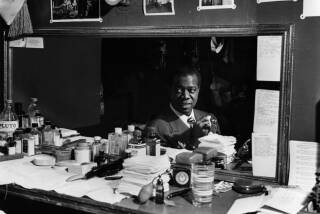O.C. JAZZ REVIEW : Art Davis Goes On to the Outer Limits
- Share via
COSTA MESA — Without opening a door or stepping foot off stage, Art Davis took his audience outside for the finale of his concert with flutist James Newton on Saturday at Orange Coast College.
The bassist-educator’s quartet headed into the great musical outdoors with swirling cacophony, emotionally charged improvisations and the kind of unbridled interplay that marks the best avant-garde music.
The composition, Davis’ own free-form “Go On,” mirrored the spirit and format of John Coltrane’s landmark “Ascension” session, a date Davis made with his saxophonist friend some 25 years ago.
It came at the end of a two-set performance that moved through ballads, blues and boogie from the quartet, a tribute to Miles Davis (no relation) in a trio setting with acoustic guitar and guitar synthesizer and even an in-your-face funk tune. Davis used this varied program to warm up the audience before testing its tolerance for the out of the ordinary. A long, noisy ovation at evening’s end proved the ploy worked.
Credit flutist Newton for putting a particularly dangerous edge to the proceedings. He played unaccompanied during the closer, building long, clean-toned runs into churning statements complicated with vocal overtones and wheezing high notes.
The untitled duet between Davis and the flutist that preceded “Go On” foreshadowed the trip to come, with Newton painting a melodic, sometimes melancholy lead over the continually shifting landscape the bassist provided.
Davis used the occasion to introduce young lions Greg Kirstin on piano and Willie Jones III on drums. Both showed impressively mature technique and a youthful enthusiasm that only rarely turned to excess.
Kirstin seemed a bit hesitant as the combo opened with Davis’ “Dr. A.D. Blues,” but he was soon showing off some wise chordal play and even a few Cecil Taylor-like rages across the length of the keyboard. Jones, who has recently been seen around Los Angeles with his band, Black Note Quartet (which won first place last month in the annual John Coltrane Festival talent contest,) gave sturdy rhythmic support while kicking-up some Billy Higgins-style cross-hand work during solos. His wildly descriptive improv during the evening’s last piece worked the future from a solid grounding in the tradition.
Guitarist and fellow Orange Coast College instructors John McEnary and Joe Poshek teamed with the bassist in a chamber-trio setting that showcased Davis’ classical phrasing on a pair of standards. Miles Davis’ “Blue and Green” found McEnary’s guitar synthesizer echoing the late trumpeter’s muted tones while Poshek added Flamenco-inspired “Sketches of Spain” color. On “Windows,” the acoustic guitarist strummed up an enticely rhythmic attack that contrasted with McEnary’s violin-like tones.
Despite the free-form fireworks that ended the show, the evening’s most surprising moments came on the bassist’s “Tell It,” a stylish funk number that Davis drove with an array of backbeat variations. Newton molded the number into something sinister with a minor-key feel punctuated with his crying overtones and bursts from his instrument. Davis used an Eastern-influenced approach during his improv, working droning bow effects and rock-steady interludes before Kirstin got going with chordal chops and slashes layered against the beat.
Davis and company were wise not to accept the invitation for an encore that came after “Go On.” After taking the audience from an earthbound blues to the outer limits of the avant-garde, where else was there left to go?
More to Read
The biggest entertainment stories
Get our big stories about Hollywood, film, television, music, arts, culture and more right in your inbox as soon as they publish.
You may occasionally receive promotional content from the Los Angeles Times.










